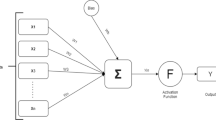Abstract
In this paper, we develop multi-layer feed-forward artificial neural network (MFANN) models for predicting the performance measures of a message-passing multiprocessor architecture interconnected by the simultaneous optical multiprocessor exchange bus (SOME-Bus), which is a fiber-optic interconnection network. OPNET Modeler is used to simulate the SOME-Bus multiprocessor architecture and to create the training and testing datasets. The performance of the MFANN prediction models is evaluated using standard error of estimate (SEE) and multiple correlation coefficient (R). Also, the results of the MFANN models are compared with the ones obtained by generalized regression neural network (GRNN), support vector regression (SVR), and multiple linear regression (MLR). It is shown that MFANN models perform better (i.e., lower SEE and higher R) than GRNN-based, SVR-based, and MLR-based models for predicting the performance measures of a message-passing multiprocessor architecture.





Similar content being viewed by others
References
Zhou X, Lu K, Wang X, Li X (2012) Exploiting parallelism in deterministic shared memory multiprocessing. J Parallel Distrib Comput 72:716–727
Culler D, Singh JP, Gupta A (2009) Parallel computer architecture: a hardware/software approach, 4th edn. Morgan Kaufmann, New York
Chow ALH, Golubchik L, Khuller S, Yaoc Y (2012) Performance tradeoffs in structured peer to peer streaming. J Parallel Distrib Comput 72:323–337
Chan F, Cao J, Sun Y (2003) High-level abstractions for message-passing parallel programming. Parallel Comput 29:1589–1621
Eeckhout L, Sampson J, Calder B (2005) Exploiting program microarchitecture independent characteristics and phase behavior for reduced benchmark suite simulation. In: Proceedings of the IEEE international symposium on workload characterization. Austin, TX, 6–8 October 2005, pp 2–12
Akay MF, Katsinis C (2008) Performance improvement of parallel programs on a broadcast-based distributed shared memory multiprocessor by simulation. Simul Model Pract Theory 16:338–352
Akay MF, Abasıkeleş I (2010) Predicting the performance measures of an optical distributed shared memory multiprocessor by using support vector regression. Expert Syst Appl 37:6293–6630
Genbrugge D, Eeckhout L (2007) Statistical simulation of chip multiprocessors running multi-program workloads. In: Proceedings of the 25th international conference on computer design, Lake Tahoe, CA, 7–10 October 2007, pp 464–471
Zayid EIM, Akay MF (2012) Computing and estimating the performance measures of a message passing multiprocessor architecture by using artificial neural networks. In: Proceedings of the 2nd international conference on computation for science and technology, ICCST-2, Niğde, Turkey, 9–11 July 2012, pp 76–77
Akay MF, Zayid EIM (2011) Predicting the performance measures of a message passing multiprocessor architecture by using artificial neural networks. In: Proceedings of the 2nd international symposium on computing in science and engineering, ISCSE-2011, Kuşadası, Turkey, 1–4 June 2011, pp 53–58
OPNET Modeler Inc. (2012) OPNET University program. http://www.opnet.com/university_program
Katsinis C (2001) Performance analysis of the simultaneous optical multi-processor exchange bus. Parallel Comput 27:1079–1115
Acacio ME, González J, García JM, Duato J (2002) The use of prediction for accelerating upgrade misses in cc-NUMA multiprocessors. In: Proceedings of the 11th international conference on parallel architectures and compilation techniques. Virginia, USA, p 155
Hesham E, Mostafa A (2005) Advanced computer architecture and parallel processing. Wiley, Hoboken
Thiele L, Wandeler E, Chakraborty S (2005) Performance analysis of multiprocessor DSPs: a stream-oriented component model. IEEE Signal Process Mag 22:38–46
Lemoff BE, Ali ME, Panatopoulos G, Flower GM, Madhavan B, Levi AFJ, Dolfi DW (2004) MAUI: enabling fiber-to-the-processor with parallel wavelength optical interconnects. J Lightwave Technol 22:2043–2054
Pratas F, Trancoso P, Sousa L, Stamatakis A, Shi G, Kindratenko V (2011) Fine-grain parallelism using multi-core, Cell/BE, and GPU systems. Parallel Comput 38:365–390
Chen M-S, Yen H-W (2011) Applications of machine learning approach on multi-queue message scheduling. Expert Syst Appl 38:3323–3335
Khashei M, Hamadani AZ, Bijari B (2012) A novel hybrid classification model of artificial neural networks and multiple linear regression models. Expert Syst Appl 39:2606–2620
Alpaydın E (2010) Introduction to machine learning, 2nd edn. MIT press, London
Firat M, Gungor M (2009) Generalized regression neural networks and feed forward neural networks for prediction of scour depth around bridge piers. Adv Eng Softw 40:731–737
Witten IH, Frank E (2005) Data mining: practical machine learning tools and techniques. Morgan Kaufmann, San Francisco
Cherkassky V, Ma Y (2004) Comparison of loss functions for linear regression. In: Proceedings of the IEEE international joint conference on neural networks, pp 400–405
Cristianini N, Shawe-Taylor J (2000) An introduction to support vector machines and other kernel-based learning methods. Cambridge University Press, Cambridge
Vapnik VN (2000) The nature of statistical learning theory. Springer, New York
Gunn SR (1998) Support vector machines for classification and regression. Technical Report, Department of Electronics and Computer Science, University of Southampton, Southampton
Schölkopf B, Smola AJ (2002) Learning with kernels: support vector machines, regularization, optimization, and beyond. MIT Press, Cambridge
Acknowledgments
We would like to thank the OPNET Technologies, Inc. for letting us use the OPNET Modeler under the University Program and to Cukurova University Scientific Research Projects Center for supporting this work (Project no: MMF2011D8). We would also like to thank Dr. Constantine Katsinis for letting us include the material about the SOME-Bus architecture in this paper.
Author information
Authors and Affiliations
Corresponding author
Rights and permissions
About this article
Cite this article
Zayid, E.I.M., Akay, M.F. Predicting the performance measures of a message-passing multiprocessor architecture using artificial neural networks. Neural Comput & Applic 23, 2481–2491 (2013). https://doi.org/10.1007/s00521-012-1267-9
Received:
Accepted:
Published:
Issue Date:
DOI: https://doi.org/10.1007/s00521-012-1267-9




